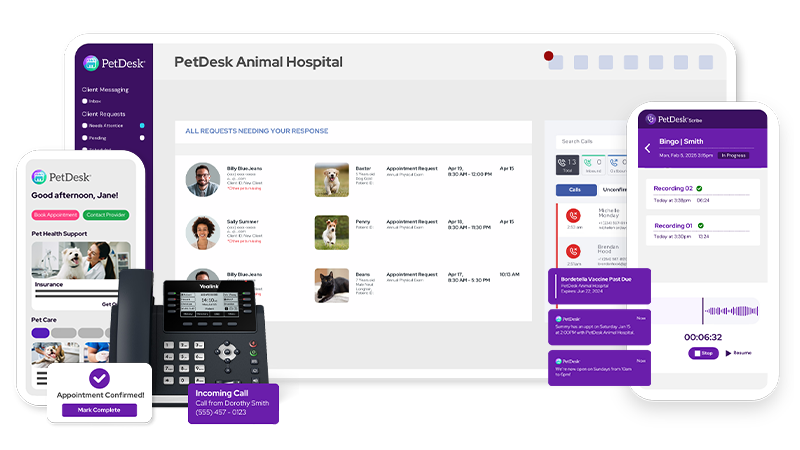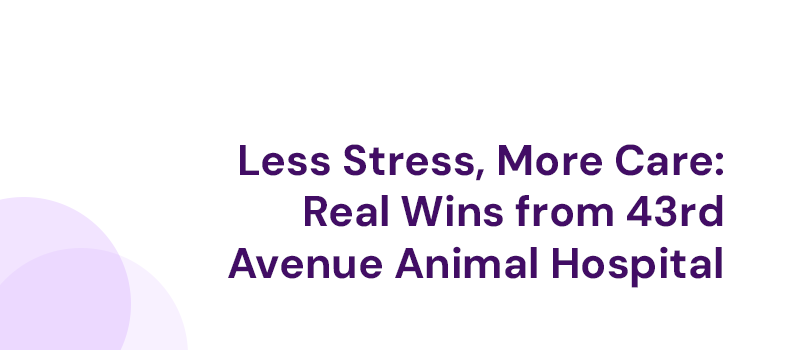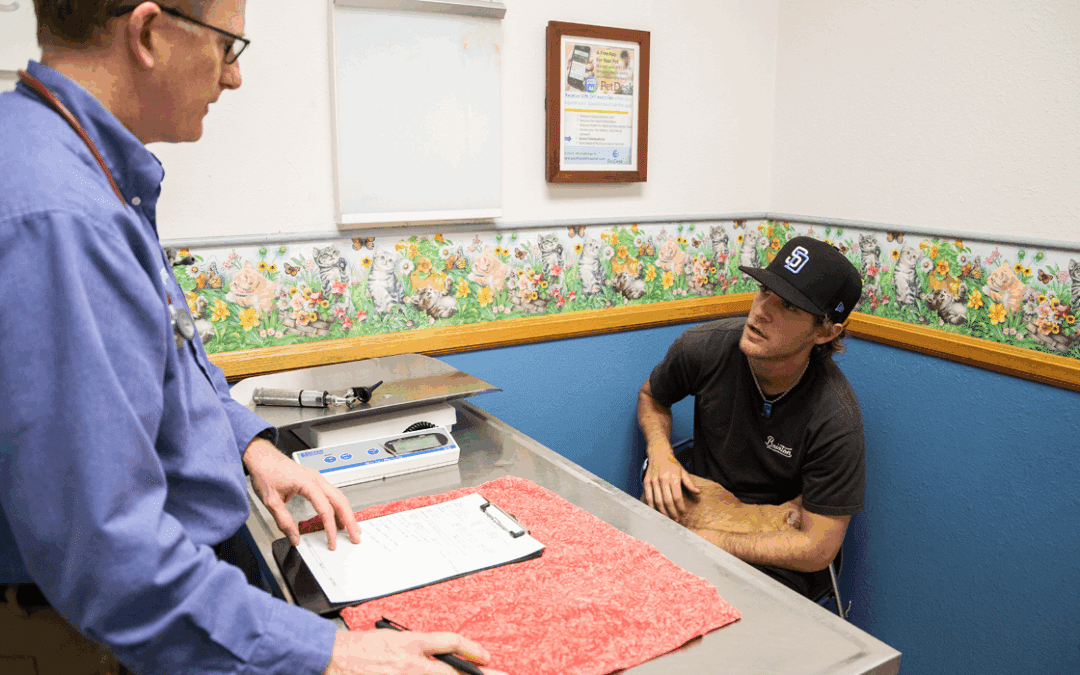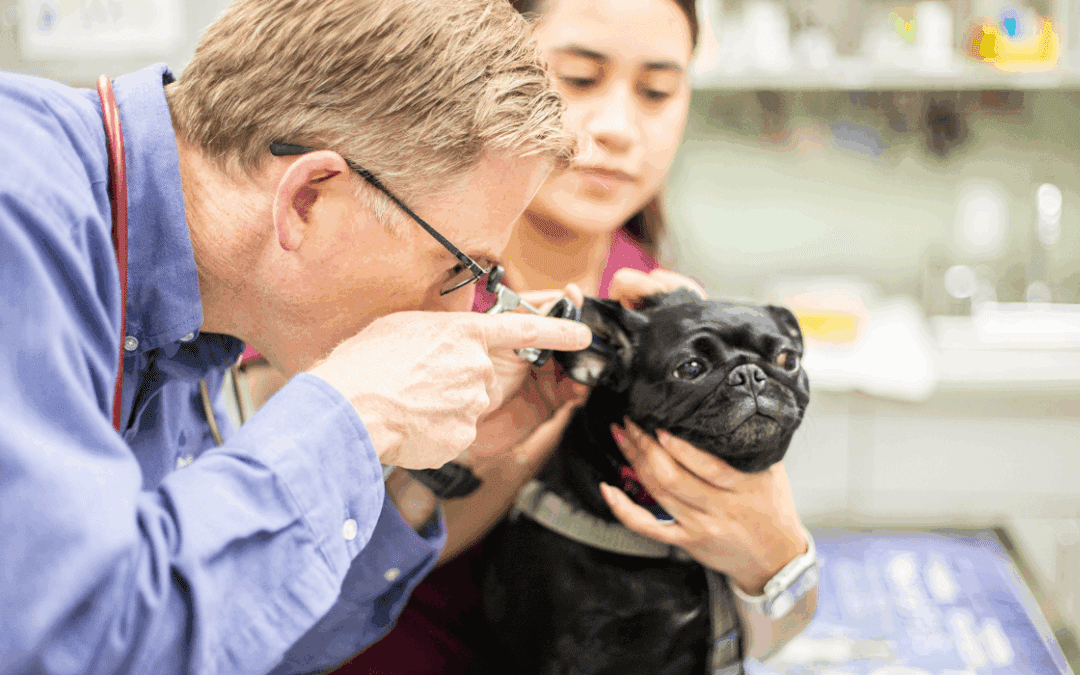Veterinary professionals face many obstacles each day, all which can quickly add up and take away valuable time from their busy routines. Documenting client and patient information is one of these challenges, often being a manual, repetitive, and time-consuming task that can prevent clinic staff from providing the best, most personalized care possible. This daily challenge—combined with long working hours and emotional client interactions—can negatively impact team morale and run the risk of occupational burnout.
Thankfully, AI-powered veterinary solutions are changing the way veterinarians document information, replacing manual processes with fast and accurate technology. From increased productivity to a healthier work-life balance, we’re covering how artificial intelligence (AI) is enhancing veterinary documentation and reducing everyday clinic stressors.
Understanding the causes of burnout in veterinary medicine
Occupational burnout in the veterinary world often comes from a combination of factors, including:
- Heavy workloads: Veterinary teams juggle appointments, surgeries, emergency cases, and administrative duties each and every day. These demanding responsibilities can quickly make professionals feel overwhelmed.
- Emotional impact: Although veterinarians enter the profession to provide the best possible care to pets, supporting pet owners and navigating difficult client conversations takes an emotional toll on team members. This is especially true when discussing critical treatment options or end-of-life decisions.
- Inefficient processes: Clinic life moves fast, and manual documentation can be a lengthy process that slows veterinary teams down. For staff, this lack of efficiency distracts from patient care and reduces the amount of breaks and personal time they have.
With so much to accomplish and manage, it’s clear that veterinary professionals can quickly feel overworked. These challenges prove the importance of introducing technology that helps clinic staff better manage their day-to-day with speed and precision.
How AI is transforming veterinary documentation
Artificial intelligence has led to many significant advancements in various industries, and veterinary medicine is no exception. By integrating AI into documentation processes, veterinary clinics can promote an environment that allows staff to spend more time on client conversations and patient care, and less time dealing with repetitive administrative work.
1. Automating note-taking
AI-powered transcription tools can capture and transcribe client conversations during appointments, which eliminates the need for manual note-taking and empowers veterinarians to focus on meaningful interactions. Advanced AI systems can even summarize key patient details, and turn them into structured medical records.
2. Managing medical records
AI systems can work perfectly with a clinic’s existing practice management software, ensuring standardized and organized records. Not only do these tools save time for clinic staff, but also reduce the risk of errors and ensure that critical information is easy to find. With a well-managed and accurate data process, veterinary clinics can improve the overall productivity of their teams day in and day out.
3. Offering smart templates and predictive text
Many AI-powered documentation tools have smart templates that are tailored to specific pet health cases. For example, a veterinarian treating a case of feline diabetes could use a certain template that automatically populates relevant fields. AI documentation tools also offer predictive text features, which suggest commonly used phrases and medical terminology to further strengthen documentation speed and accuracy.
4. Providing data analysis and insights
Veterinary AI solutions aren’t made to only document—they can analyze, too! By identifying patterns in patient data, AI technology can assist veterinarians in diagnosing conditions, recommending treatment plans, and monitoring pet health outcomes. This saves veterinary teams time while also promoting better patient care.
The impact of AI on reducing occupational burnout within the veterinary industry
With less manual documentation and physical paperwork, AI solutions offer several advantages that directly help combat the threat of veterinary burnout.
Better work-life balance
Simplifying daily documentation processes reduces the amount of time veterinarians spend finalizing notes after hours, or worrying about forgotten patient details. Allowing for more time to rest and recharge each day is crucial for maintaining mental and physical health.
Improved job satisfaction
Spending less time on administrative tasks allows veterinary professionals to dedicate more energy to the aspects of their job that they find most rewarding—whether it’s treating patients, educating pet parents, or strengthening their own professional skills.
Increased confidence
AI tools help manage the complexity of documenting client and patient details, which reduces the likelihood of errors and allows veterinarians to more easily make well-informed decisions about a pet’s health. Most importantly, less errors and more efficiency gives veterinarians the peace of mind and confidence they need to successfully go about their days.
See what PetDesk makes possible
Our solutions are designed to tackle your clinic’s specific challenges.
Set up time with a PetDesk expert to see for yourself!
Overcoming implementation challenges at your veterinary clinic
Artificial intelligence is certainly a powerful resource for veterinary clinics, but adding AI to your operations isn’t just a one-and-done experience. This technology can come with different challenges depending on your clinic, and may require not only significant financial investment but also ongoing training and optimization.
Initial costs
With so much to offer, reliable AI technology doesn’t usually come cheap. Many practices, however, find that improved team productivity and long-term savings in time far outweigh the initial financial investment.
Training and adaptation
New technology takes time to adjust to, and staff may need continuous training to adapt to and become proficient with these AI systems. Clinics can help ease this transitional period for their teams by creating a phased implementation plan and establishing ongoing, hands-on support.
Data security
It’s absolutely imperative that AI tools comply with all federal and local data privacy regulations. That’s why veterinary practices need to work with well-known and trusted technology providers to ensure their client and patient information is protected from data breaches and other security threats—at all times.
Veterinary success stories: AI in action
The increasing awareness and adoption of AI technology has allowed many veterinary practices to already begin benefiting from AI-powered documentation tools in different ways. For example, clinics using voice-to-text transcription tools report significant time savings, while others praise the predictive capabilities of AI for simplifying record-keeping and improving diagnostic accuracy.
The future of AI in veterinary medicine
As artificial intelligence continues to evolve, its potential in veterinary medicine is limitless. Over the next several years and beyond, we’ll see continuous development in AI-driven advancements such as:
- Assisted imaging: Clinics can rely on AI to continue enhancing diagnostic accuracy in radiology and ultrasound, further saving valuable time and leading to effective patient care.
- Chatbots for client communication: Team members can stay focused on supporting pet owners and caring for pets while counting on AI messaging to answer routine pet health questions, schedule non-urgent appointments, and much more.
- Personalized treatment plans: While veterinarians know what’s best for pets, they can use AI to analyze data from similar cases, and have the technology recommend evidence-based treatments that are tailored to individual patients.
Reward yourself with reliable AI technology
Not enough time in the work day, long hours, and the emotional toll of patient care are all daily risk factors for veterinary occupational burnout. AI-powered documentation tools are here to make things easier for veterinary professionals like you by saving valuable time, increasing productivity, and ultimately providing a healthier work-life balance.
By incorporating AI into your documentation processes, you can automate manual, time-consuming, and repetitive tasks while staying more attentive to clients and their pets. You deserve technology that supports your well-being as much as you support the well-being of pets, so reward yourself with fast, accurate, and reliable AI-powered technology that gives you and your clinic a well-earned boost.
AI Documentation and Burnout in the Veterinary Industry FAQs
Q. How does AI documentation help reduce burnout in veterinary professionals?
A. AI-powered documentation streamlines the process of recording client and patient information, eliminating time-consuming manual note-taking. This allows veterinary teams to focus more on patient care and client interactions rather than administrative tasks, reducing stress and workload.
Q. Can AI help veterinarians save time on paperwork?
A. Yes! AI-driven tools like voice-to-text transcription, smart templates, and predictive text significantly cut down the time needed to document patient visits. This means veterinarians spend less time on after-hours documentation and more time on rest and recovery.
Q. How does AI improve the accuracy of veterinary records?
A. AI integrates with practice management software to standardize records and reduce the risk of errors. Predictive text and smart templates ensure that documentation remains consistent, making patient records more accurate and easily accessible.
Q. Will AI documentation help with client interactions?
A. Absolutely! With AI handling note-taking and medical record management, veterinarians can fully engage with clients, strengthening trust and communication without being distracted by administrative work.
Q. Does AI documentation support better work-life balance?
A. Yes, by automating repetitive tasks and reducing after-hours paperwork, AI allows veterinary professionals to have more personal time. A better work-life balance is crucial for preventing burnout and maintaining overall well-being.
Q. What are some challenges veterinary clinics might face when implementing AI documentation?
A. Some challenges include the initial cost of AI tools, staff training and adaptation, and ensuring data security. However, the long-term benefits—such as increased efficiency, reduced stress, and improved patient care—make AI a worthwhile investment.
Q. How can veterinary teams successfully integrate AI into their documentation processes?
A. To ensure a smooth transition, clinics should implement AI gradually, provide ongoing training, and work with trusted technology providers to ensure compliance with data security regulations. With proper planning, AI can become a valuable asset in reducing workplace stress.
See the power of PetDesk for yourself—for free
Save time and grow your business with an AI-transcription platform, custom websites and digital marketing, 24/7 error-free booking, a PIMS-VoIP phone system, plus a client engagement platform with a mobile app.









